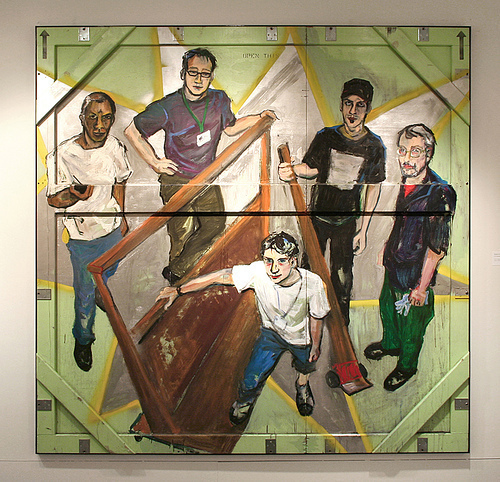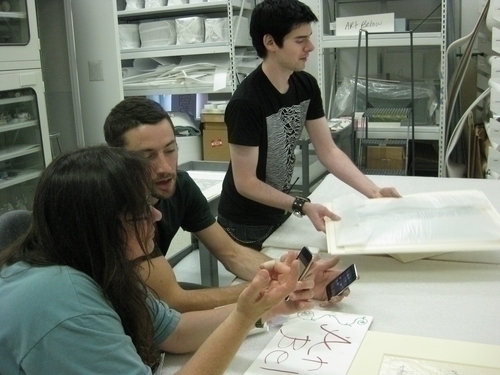Art Handlers Go Mobile with iPod Touch and ArtSee
If you read the blog, you know we talk about our web initiatives all the time, but we rarely discuss the work we do on internal projects. The web side of the Technology Department is charged with developing the stuff you see—both the website and the gallery technology—and the stuff you don’t like internal applications that can assist Brooklyn Museum staff and their daily workflow. Normally we don’t blog about these internal applications, but this seems interesting enough that wanted to give it a quick run down.

Elaine Komorowski. Art Handlers, Brooklyn Museum, 2006. Oil on wood.
Many of our readers who’ve seen our behind the scenes sets of various exhibitions loading in have come to catch a glimpse of our fabulous team of Art Handlers and the type of work they do here on a daily basis. The handlers are always out and about working in the galleries and the storerooms to ensure that art is moved safely throughout the building. In contrast to other staffers at the museum, they don’t have stationary desks with workstations, so we really needed to provide a solution for their computing needs that was more appropriate to their situation.

Elaine and Jason looking over their new work tool, the iPod Touch with Artsee.
ArtSee is a web app formatted for the iPod Touch 3″ screen and it runs a mobile version of our collection management system that we designed specifically for the needs of our Art Handlers. Each member of the art handling staff has been given an iPod Touch so they can go into storage or the galleries and query an object’s location and other information. Lucky for us, Apple started supporting Exchange on these devices, so Art Handlers have easy access to Brooklyn Museum e-mail and are now in the pilot stages of e-mailing location reports back to the Collection Management team as objects are moved throughout the building. In addition, Registrars are now using iPod Touches for web and e-mail access during courier trips and small things like currency conversion apps can sure make their life a bit easier on the road. Registrars are also now utilizing mobile battery-operated printers to help them photograph objects and print records for condition reports as works arrive on site.
As it turns out, the solution came about from a confluence of events. First, since 2002 we’ve had a wifi network running throughout the museum. The wifi network was established for free public use, but we always had an eye toward utilizing it for staff and had wired up the storage spaces and the mechanical rooms at the same time we did the public galleries. Second, the iPod Touch became pretty near to a fully-functional and affordable computing platform. Last but not least, we put the collection online and that involved working with our database-driven business systems (such as our collections database, digital asset management system, etc.) to move various sets of data around, so it could form the foundation of web applications like the online collection and internal applications such as ArtSee. For all the tech heads out there, Paul Beaudoin, the programmer in charge of making all this data play nicely together, has put together some nice documentation about how all this data moving works behind the scenes. It’s in a wiki for the curious, so e-mail us for an invite.
We are still in the early stages, but are hearing good things so far. You just can’t underestimate the smiling, giddy faces on the Tech team when someone says, “It changed the way I work for the better!” Yay!

Shelley Bernstein is the former Vice Director of Digital Engagement & Technology at the Brooklyn Museum where she spearheaded digital projects with public participation at their center. In the most recent example—ASK Brooklyn Museum—visitors ask questions using their mobile devices and experts answer in real time. She organized three award-winning projects—Click! A Crowd-Curated Exhibition, Split Second: Indian Paintings, GO: a community-curated open studio project—which enabled the public to participate in the exhibition process.
Shelley was named one of the 40 Under 40 in Crain's New York Business and her work on the Museum's digital strategy has been featured in the New York Times.
In 2016, Shelley joined the staff at the Barnes Foundation as the Deputy Director of Digital Initiatives and Chief Experience Officer.
